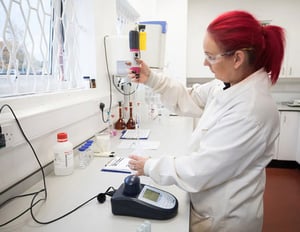Personal Assets Trust Plc (LON:PNL), today announced interim results for the Six months ended 31 October 2018 (Unaudited)
Financial Summary
•Personal Assets Trust plc is an independent investment trust run expressly for private investors.
•The Company’s investment policy is to protect and increase (in that order) the value of shareholders’ funds per share over the long term.
•Over the six months to 31 October 2018 PAT’s net asset value per share rose by 1.9% to £395.50. PAT’s share price rose by £8.00 to £400.00 over the same period, being a premium of 1.1% to the Company’s NAV at that date.
•During the period, PAT continued to maintain a high level of liquidity.
|
|
% as at 31 October 2018 |
% as at 30 April 2018 |
|
||
|
|
|
|
|
|
|
|
US TIPS |
|
27.4 |
20.0 |
|
|
|
US Treasuries |
|
4.2 |
2.7 |
|
|
|
UK Index-Linked Gilts |
|
3.5 |
3.6 |
|
|
|
UK T-Bills |
|
16.6 |
22.5 |
|
|
|
Gold Bullion |
|
8.4 |
8.9 |
|
|
|
UK cash |
|
3.7 |
4.3 |
|
|
|
Overseas cash |
|
– |
0.5 |
|
|
|
Net current liabilities |
|
(1.2) |
(0.9) |
|
|
|
Total |
|
62.6 |
61.6 |
||
•Over the six months PAT’s shares continued to trade close to NAV. We issued 78,903 new Ordinary shares (adding £31.4 million of new capital) at a small premium.
•Dividends are paid in July, October, January and April of each year. The first interim dividend of £1.40 per Ordinary share was paid to shareholders on 13 July 2018 and the second interim dividend of £1.40 was paid on 12 October 2018. A third interim dividend of £1.40 per Ordinary share will be paid to shareholders on 10 January 2019 and a fourth interim dividend of £1.40 per Ordinary share is expected to be paid in April 2019, making a total for the year of £5.60 per Ordinary share.
Key Features
|
|
|
As at 31 October 2018 |
As at 30 April 2018 |
|
|
|
|
|
|
Market Capitalisation |
|
£916.5m |
£867.3m |
|
Shareholders’ Funds |
|
£906.2m |
£858.9m |
|
Shares Outstanding |
|
2,291,336 |
2,212,433 |
|
Liquidity (see fourth bullet point above) |
|
62.6% |
61.6% |
|
Share Price |
|
£400.00 |
£392.00 |
|
NAV per Share |
|
£395.50 |
£388.21 |
|
FTSE All-Share Index |
|
3,904.23 |
4,127.68 |
|
Premium to NAV |
|
1.1% |
1.0% |
|
Earnings per Share |
|
£2.88 |
£5.23⁽¹⁾ |
|
Dividend per Share |
|
£2.80 |
£5.60⁽¹⁾ |
|
|
|
|
|
|
⁽¹⁾ Full Year. |
|||
Portfolio as at 31 October 2018
|
|
|
|
S/holders’ Funds |
Valuation |
Bought/(sold) |
Gain/ (loss) |
|
Security |
Country |
Equity Sector |
% |
£’000 |
£’000 |
£’000 |
|
|
|
|
|
|
|
|
|
Microsoft |
USA |
Technology |
3.6 |
32,209 |
– |
6,068 |
|
Coca-Cola |
USA |
Beverages |
3.3 |
30,376 |
– |
4,962 |
|
Philip Morris |
USA |
Tobacco |
3.0 |
27,582 |
– |
3,760 |
|
Nestlé |
Switzerland |
Food Producer |
2.9 |
26,240 |
(4,415) |
3,963 |
|
British American Tobacco |
UK |
Tobacco |
2.6 |
23,754 |
– |
(4,239) |
|
Unilever |
UK |
Food Producer |
2.6 |
23,316 |
– |
385 |
|
Altria |
USA |
Tobacco |
2.5 |
22,419 |
– |
4,492 |
|
Berkshire Hathaway |
USA |
Insurance |
2.3 |
20,487 |
– |
2,529 |
|
American Express |
USA |
Financial Services |
2.0 |
17,695 |
– |
1,918 |
|
Procter & Gamble |
USA |
Household Products |
1.8 |
16,251 |
– |
3,959 |
|
Imperial Oil |
Canada |
Oil & Gas |
1.7 |
15,583 |
– |
1,138 |
|
Sage Group |
UK |
Technology |
1.6 |
14,699 |
– |
(2,446) |
|
Colgate Palmolive |
USA |
Personal Products |
1.5 |
13,200 |
– |
(204) |
|
A.G. Barr |
UK |
Beverages |
1.3 |
11,700 |
– |
1,042 |
|
Diageo |
UK |
Beverages |
1.2 |
11,078 |
– |
497 |
|
UK |
Pharmaceuticals |
1.0 |
9,514 |
– |
312 |
|
|
Franco-Nevada |
Canada |
Mining |
1.0 |
8,734 |
2,749 |
(293) |
|
Société BIC |
France |
Consumer Goods |
0.8 |
7,484 |
– |
84 |
|
Henkel |
Germany |
Consumer Goods |
0.7 |
6,441 |
(5,384) |
(659) |
|
Hershey |
USA |
Food Producer |
– |
– |
(8,376) |
210 |
|
PZ Cussons |
UK |
Personal Products |
– |
– |
(2,479) |
(232) |
|
Total Equities |
|
|
37.4 |
338,762 |
(17,905) |
27,246 |
|
US TIPS |
USA |
|
27.4 |
248,273 |
63,581 |
13,164 |
|
US Treasuries |
USA |
|
4.2 |
37,715 |
12,274 |
2,295 |
|
UK Index-Linked Gilts |
UK |
|
3.5 |
31,816 |
602 |
100 |
|
UK T-Bills |
UK |
|
16.6 |
150,541 |
(43,155) |
– |
|
Gold Bullion |
|
|
8.4 |
76,248 |
– |
(639) |
|
Total Investments |
|
97.5 |
883,355 |
15,397 |
42,166 |
|
|
UK cash |
|
3.7 |
33,880 |
n/a |
n/a |
|
|
Overseas cash |
|
0.0 |
209 |
n/a |
n/a |
|
|
Net current liabilities |
|
(1.2) |
(11,215) |
n/a |
n/a |
|
|
TOTAL PORTFOLIO |
|
100.0 |
906,229 |
n/a |
n/a |
|
Geographic Analysis of Investments and Currency Exposure As At 31 October 2018
|
|
UK |
USA |
Canada |
France |
Germany |
Switzerland |
Total |
|
|
% |
% |
% |
% |
% |
% |
% |
|
Equities |
10 |
19 |
3 |
1 |
1 |
3 |
37 |
|
Inflation-Linked Securities |
4 |
27 |
– |
– |
– |
– |
31 |
|
T-Bills |
17 |
– |
– |
– |
– |
– |
17 |
|
Treasuries |
– |
4 |
– |
– |
– |
– |
4 |
|
Gold Bullion |
– |
8 |
– |
– |
– |
– |
8 |
|
Cash |
4 |
– |
– |
– |
– |
– |
4 |
|
Net current liabilities |
(1) |
– |
– |
– |
– |
– |
(1) |
|
Total |
34 |
58 |
3 |
1 |
1 |
3 |
100 |
|
Net currency exposure % |
72 |
20 |
3 |
1 |
1 |
3 |
100 |
Investment Adviser’s Report
Over the half year to 31 October 2018 the net asset value per share of Personal Assets Trust rose by 1.9% while the FTSE All-Share Index fell 5.4%.
The American economist Hyman Minsky famously identified the ‘Minsky Moment’ when ‘Stability breeds instability’, and 2017 was a year of remarkable stability. Stock market volatility was at record lows, sentiment was positive and smooth sailing was anticipated. But high equity market valuations were flashing danger, and in retrospect 2017’s stability was indeed a warning signal. In 2018 stock markets have stumbled twice, once in February and again in October. The October dip confirmed that we were entering a period of turbulence for risk assets. From the ‘New Normal’ of permanently low interest rates and quantitative easing we have been witnessing the attempt by central bankers to return to an earlier ‘normality’ of tighter monetary conditions. How this will work after almost a decade of monetary munificence is unpredictable, such an exit never having been attempted before.
To date this tightening has exhibited a classic pattern, the fringe being affected first but the effects slowly shifting towards the centre. This time it began with the collapse of Bitcoin and other cryptocurrencies in December (the dotcoms of today?). Emerging markets topped out long ago, hindered by a resurgent US dollar, while developed markets (with the exception of the United States) peaked in January. The Chinese stock market has fallen sharply this year on the threat of rising trade tensions and weaker economic data. In the US, value-insensitive buying was becoming increasingly concentrated in a short list of technology-related growth stocks. The concentration of performance in a small number of large cap stocks often occurs close to the peak of stock market cycles, and October’s precipitous falls in these stocks suggest that we may have seen the peak of this cycle.
After benefiting from record profit margins and gorging on cheap debt, companies face the rising costs of labour that come with record low unemployment and a rising cost of money while vulnerabilities are now being exposed. Our asset allocation, with just over a third of the portfolio in equities, is accordingly as cautious as it has been since before the financial crisis a decade ago. Our concern is that after decades of falling yields, fixed income will not provide the portfolio protection it has in the past. (Interestingly, bonds failed to rally during the recent equity market falls.) However, liquidity, in the form of cash, short-dated index linked bonds and gold, offers some protection, while currencies offer little opportunity with the exception of a resurgent US dollar, to which we have some exposure.
Despite the recent stock market falls, the effects of tighter monetary conditions are just beginning to play out and it is too early to shift the portfolio significantly. We made only very modest changes during the six months, increasing our holdings of US TIPS and Franco-Nevada on weakness. We sold our small holding in Hershey, initiated 18 months ago. This was a much shorter holding period than usual but after Hershey agreed to acquire Amplify Snack Brands in December for $1.6bn or 48x (adjusted) earnings, a meeting with management confirmed their appetite for further deals outside the core chocolate market. In seeking to preserve capital it is necessary to avoid companies which make expensive acquisitions by over-levering their balance sheets. Otherwise, holdings in US stocks performed respectably, particularly Microsoft, Philip Morris, Procter & Gamble and Coca-Cola. We are encouraged by management actions at P&G and Coke to concentrate less on market share gains and more on price and product mix. Our UK stocks lagged somewhat, including British American Tobacco and Sage. The latter suffered from over-promising and under-delivering, but the business remains an attractive one with recurring revenues from its installed base of six million customers.
Looking into 2019, monetary conditions are only likely to get tighter with the European Central Bank, following the Federal Reserve, committed to retreating from quantitative easing. Earnings momentum from tax cuts will begin to dissipate while GDP growth is likely to taper. However, barring a material deterioration in conditions, central bankers will be reluctant to step in and rescue markets. For those with liquidity, bargain hunting may not be too far away.
Sebastian Lyon, Investment Adviser
On behalf of the Board,
Robin Angus, Personal Assets Trust Executive Director







































